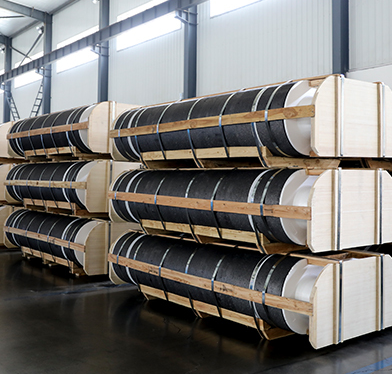Graphite is a compound composed of carbon elements. Its atomic structure is arranged in a hexagonal honeycomb pattern. Three of the four electrons outside the atomic nucleus form strong and stable covalent bonds with the electrons of adjacent atomic nuclei, and the extra atom can move freely along the plane of the network, giving it the property of electrical conductivity.
Precautions for the use of graphite electrodes
1. Moisture-proof – Avoid rain, water or dampness. Dry before use.
2. Anti-collision – Handle with care to prevent damage from impact and collision during transportation.
3. Crack prevention – When fastening the electrode with bolts, pay attention to the force applied to prevent cracking due to force.
4. Anti-breakage – Graphite is brittle, especially for small, narrow and long electrodes, which are prone to breakage under external force.
5. Dust-proof – Dust-proof devices should be installed during mechanical processing to minimize the impact on human health and the environment.
6. Smoke prevention – Electrical discharge machining is prone to generating a large amount of smoke, so ventilation devices are required.
7. Prevention of carbon deposition – Graphite is prone to carbon deposition during discharge. During discharge processing, it is necessary to closely monitor its processing state
Comparison of Electrical Discharge Machining of Graphite and Red Copper Electrodes (Complete mastery required)
1. Good mechanical processing performance: The cutting resistance is 1/4 of that of copper, and the processing efficiency is 2 to 3 times that of copper.
2. The electrode is easy to polish: The surface treatment is easy and free of burrs: It is easy to be manually trimmed. Simple surface treatment with sandpaper is sufficient, which greatly avoids shape distortion caused by external force on the electrode’s shape and size.
3. Low electrode consumption: It has good electrical conductivity and low resistivity, being 1/3 to 1/5 of that of copper. During rough machining, it can achieve lossless discharge.
4. Fast discharge speed: The discharge speed is 2 to 3 times that of copper. The gap in rough machining can reach 0.5 to 0.8 mm, and the current can be as large as 240A. The electrode wear is small when used normally for 10 to 120 years.
5. Light weight: With a specific gravity of 1.7 to 1.9, which is 1/5 of that of copper, it can significantly reduce the weight of large electrodes, lower the load on machine tools and the difficulty of manual installation and adjustment.
6. High-temperature resistance: The sublimation temperature is 3650℃. Under high-temperature conditions, the electrode does not soften, avoiding the deformation problem of thin-walled workpieces.
7. Small electrode deformation: The coefficient of thermal expansion is less than 6 ctex10-6 /℃, which is only 1/4 of that of copper, improving the dimensional accuracy of discharge.
8. Different electrode designs: Graphite electrodes are easy to clean corners. Workpieces that usually require multiple electrodes can be designed into a single complete electrode, improving the accuracy of the mold and reducing the discharge time.
A.The machining speed of graphite is faster than that of copper. Under correct usage conditions, it is 2 to 5 times faster than copper.
B. There is no need to consume a large amount of working hours for deburring like copper does;
C. Graphite has a fast discharge rate, which is 1.5 to 3 times that of copper in rough electrical processing
D. Graphite electrodes have low wear and tear, which can reduce the usage of electrodes
E. The price is stable and is less affected by market price fluctuations
F. It can withstand high temperatures and remains undistorted during electrical discharge machining
G. It has a small coefficient of thermal expansion and high mold precision
H. Light in weight, it can meet the requirements of large and complex molds
The surface is easy to process and it is easy to obtain a suitable processing surface
Post time: Apr-22-2025

